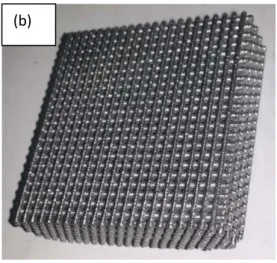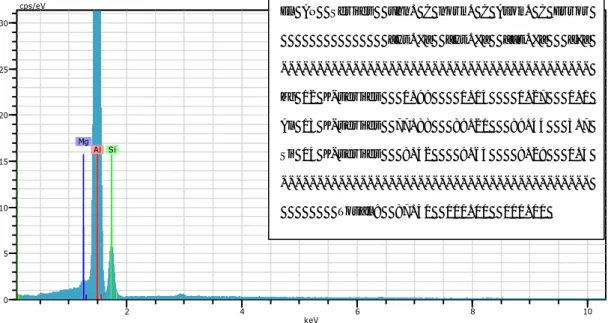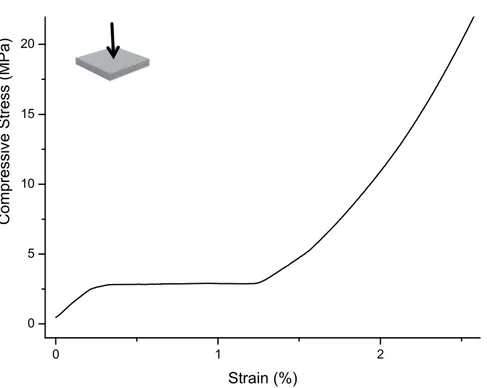* Corresponding Author
Received: 25 January 2018 Accepted: 04 June 2018
Al-Si-Mg Foam Produced by 3D Printer
Selçuk ATALAY1, Nevzat BAYRİ2, Harun KAYA1, Tekin İZGİ1,*, V. Serkan KOLAT1
1İnönü University, Faculty of Arts and Sciences, Department of Physics, 44280 Malatya, Türkiye,
selcuk.atalay@inonu.edu.tr , harun.kaya@inonu.edu.tr , tekin.izgi@inonu.edu.tr , veli.kolat@inonu.edu.tr
2İnönü University, Faculty of Education, Department of Science Education, 44280 Malatya, Türkiye,
nevzat.bayri@inonu.edu.tr
Abstract
Al89.5Si10Mg0.5 metallic foam was produced by 3D metal printer. The design
pattern has a triangular-like structure and it consists of aligned wires. The structure was
designed so that the distance between wires is 1 mm and the wire diameter is 1.2 mm.
X-ray results showed that sample has a cubic structure with nm grains. Also, detailed element mapping indicated that sample has a homogenous distribution state of the reinforcement throughout the Al matrix, which also a clear indication of single phase. Compressive stress–strain curves shows the typical compressive behaviour of metallic
foams consists of a narrow linear elastic area followed by a plateau regime and then a sharp increase.
Keywords: Metallic foam, 3D printer, Compressive stress. 3D Yazıcı Tarafından Üretilen Al-Si-Mg Köpük
Özet
Al89.5Si10Mg0.5 metalik köpük 3D metal yazıcı ile üretildi. Tasarım deseni üçgen
benzeri bir yapıya sahiptir ve hizalanmış tellerden oluşur. Yapı, teller arasındaki mesafe 1 mm ve tel çapı 1.2 mm olacak şekilde tasarlanmıştır. X-ışını sonuçları numunenin nm
dergipark.gov.tr/adyusci
tanecikli kübik bir yapıya sahip olduğunu gösterdi. Ayrıca, detaylı element haritalaması ile numunenin Al matrisi boyunca homojen bir dağılım durumuna sahip olduğunu ve aynı zamanda tek faza sahip olduğu belirtildi. Basınca bağlı gerilme-şekil değiştirme eğrileri, dar bir doğrusal elastik alan boyunca keskin bir artış meydana getirdiği, dolayısıyla bu da metalik köpüklerin tipik basınç davranışı özelliğini göstermektedir.
Anahtar Kelimeler: Metalik köpük, 3D yazıcı, Baskı gerilimi.
Introduction
Metal foams have found application in many areas including aerospace, electronics and automotive among others [1-6]. Mechanical, thermal and acoustic properties of metal foams are making them attractive for various applications [5-6]. Addition to their current applications, metal foams are found to be useful for the construction of light weight structures, filters, energy absorption devices, currently being used by some vehicle manufacturers [4, 7]. Particularly, automotive industry requires light materials with crash safe structure, efficient thermal conductivity, energy absorber etc. [7-9]. In this sense, Aluminium alloys or aluminium foams looks possible material.
There are many methods to produce Al foams [10-14], but it is not possible to control the dimensions and distributions of pores in the most of the previously reported methods. Since, the foam produced by these methods has a structure of randomly distributed metal and voids. Consequently, the structure is not homogeneous through the sample and moreover, it cannot be reproduced with the same void size and distributions exactly. This leads to change in the mechanical properties of sample and degree of porosity. Modern technology gives us this opportunity, because today design and production of materials are much easier using 3-D metal printers. Many types of materials have been produced by 3-D metal printers and these materials have found application in many areas like; biotechnology, artificial organs, electrode, batteries, electronic and some ultralight materials [15-17].
In the previous studies, mostly mechanical properties of foam were reported [18-21]; in this article we present structural and mechanical properties together. We have produced Al foam using 3-D printer and the structural and mechanical properties of the produced foam are reported. The designed foam has triangular pores shape and homogenously distributed with pore size of 1 mm.
Materials and Methods
Al foam was produced by Shapeways Company. The aluminium foam material was printed with about 89.5% aluminium, 10% silicon, and 0.5% magnesium powders. We need to use silicon due to production process of foam by 3-D printer and magnesium to improve mechanical properties. It has been also reported that Aluminium–Silicon alloys are of great importance to engineering industries as they exhibit high strength to weight ratio, high wear resistance, low density, low coefficient of thermal expansion etc. [22]. Therefore, we assumed that Al addition has a positive effect on the mechanical properties of foam. In the production process, laser melting uses a high powered laser to fuse fine metallic powders together. Fabrication takes place on a build platform with supports to anchor the part. A bed of 89.5% aluminium, 10% silicon, and 0.5% magnesium powder sits above this build platform. One layer at a time, the powder is melted by a laser and then quickly cooled to solidify the metal. This process is repeated until the part is completed. Horizontal areas and edges print with an automatically generated support structure to prevent the feature from sagging into loose powder. The support is then removed and polished away from the foam during post-processing [23].
In order to analyse the foam’s mechanical properties the specimens were submitted to uniaxial compressive tests. Tests were performed in a universal testing machine Instrom at room temperature and in air. Structural properties of materials were investigated using X-ray, SEM, EDX systems. The X-ray diffractograms were recorded with a power diffractometer at room temperature using Cu-Ka radiation. A LEO EVO 40 VP SEM system attached to a Röntec 3000 detector was used and micro structural analysis was carried out on an energy-dispersive EDX system. Colour mapping and
phase formation results were investigated using electron probe microscopy analysis (EPMA) results from the same detector. Foam is polished and cleaned before X-ray, SEM and EDX analysis.
Results and Discussion
3-D metal printer gives us an opportunity to design and create ordered structures with highly controlled and predictable properties. The design pattern has a triangular-like structure schematically illustrated in Figure 1a. In the first layer, the wires are arranged in parallel to each other to form a horizontal plane. The structure is designed so that the distance between wires is 1mm and the wire diameter is 1.2 mm (Figure 1).
The wires in subsequent layer are oriented orthogonally to the wires in the previous layer. Additionally, the wires on the two layers lower are arranged below the spaces in the two upper layers. In other words, every other layer is shifted orthogonally to the wire direction by half the pitch relative to two layers below it, which leads to the structure to repeat every four layers. Such a design form a triangular structure as can be seen in Figure 1a. The produced foam has 50*50 mm dimensions and has 16 mm width. The picture of produced foam is given in Figure 1b. It was calculated that the structure has a volume fraction of about 0.40.
Figure 1. a) Schematic illustration of design triangular foam, b) Picture of produced foam.
X-ray spectrum of foam shows that sample has an exactly same peaks with Al3.21Si0.47 structure, sample has a cubic structure with a single phase and no impurities
are exist (Figure 2). The average crystallite size, D, was calculated using Debye-Scherer equation after correction of instrumental broadening. D is given by λ/(FWHM* Cos ), where λ is wavelength of x-ray, FWHM is the full width at half maximum of max peak in x-ray spectrum and is the Bragg angle [24]. The calculated D value is about 20 nm. SEM pictures show that surface of materials smooth and clean (Figure 3). EDX analysis performed on the different section of sample and found Al 89.21%, Si 9.65% and Mg 1.14% throughout sample (Figure 4). This percentage of Al, Si and Mg are in good agreement with starting percentages.
Figure 2. X-ray spectrum of foam.
2 4 6 8 10 keV 0 5 10 15 20 25 30 cps/eV Al Si Mg
Figure 4. EDX spectrum and results.
Figure 5 shows the EDX element mapping of foam, corresponding to the distributions of Al, Si and Mg. Each element was indicated by a different colour. In colour mapping, Al was represented by green, Si by green and Mg by dark blue. The small pictures show the distribution of each element in the picture. This colour element mapping clearly shows that sample has a homogenous distribution state of the reinforcement throughout the Al matrix, which also a clear indication of single phase.
Figure 5. EDX elements mapping of foam. Al was represented by green, Si by green and Mg by dark
blue.
El AN Series unn. C norm. C Atom. C Error [wt.%] [wt.%] [at.%] [%] --- Mg 12 K-series 0.99 1.14 1.27 0.1 Al 13 K-series 77.88 89.21 89.44 3.7 Si 14 K-series 8.42 9.65 9.29 0.4 --- Total: 87.30 100.00 100.00
Figure 6 presents the compressive stress–strain curves obtained for Al foams, which shows the typical compressive behaviour of metallic foams which consists of a narrow linear elastic area followed by a plateau regime in which foams compress at a relatively constant stress over a prolonged strain range. The foam has 2.7 MPa Yield stress and an average plateau stress of 2.85 MPa, these values of the current foam is comparable to previously reported values of Al foam produced by 3D printer [10-11].
Figure 6. Compressive stresses versus strain curve.
Conclusions
Three-dimensional printing of Al-Si-Mg foam was successfully designed and produced. Details structural analysis by X-ray, SEM and EDX showed that sample has a cubic crystal structure and elements spread homogeneously throughout the foam.
Compressive stress response was studied in printed foam. It was found that Compressive stress increases first linearly and then remains nearly constant with
0 1 2 0 5 10 15 20 Com p re ssiv e S tres s ( M Pa) Strain (%)
increasing strain. The Yield stress and an average plateau stress are 2.7 MPa and 2.85 MPa, respectively.
Acknowledgement
This work was supported by İnönü University, scientific project unit with project number 834/2017.
References
[1] Banhart, J., Manufacture, characterisation and application of cellular metals
and metal foams, Progress in Materials Science, 46, 559, 2001.
[2] Wen, C. E., Mabuchi, M., Yamada, Y., Shimojima, K., Chino, Y., Asahina, T., Processing of biocompatible porous Ti and Mg, Scripta Materialia, 45, 1147, 2001.
[3] Schaedler, T. A., Jacobsen, A. J., Torrents, A., Sorenseni A. E., Lian, J., Greer, J. R., Valdevit, L., Carter, W. B., Ultralight metallic microlattices, Metallic Microlattices Science, 334, 962, 2011.
[4] Ubertalli, G., Ferraris, M., Bangash, M. K., Joining of AL-6016 to Al-foam using Zn-based joining materials, Composites Part A - Applied Science and Manufacturing, 96, 122, 2017.
[5] Giani, L., Groppi, G., Tronconi, E., Heat transfer characterization of metallic foams, Industrial & Engineering Chemistry Research, 44, 9078, 2005.
[6] Lefebvre, L. P., Banhart, J., Dunand, D. C., Porous metals and metallic foams: Current status and recent developments, Advanced Engineering Materials, 10 (9), 775, 2008.
[7] Kroupova, I., Bednarova, V., Elbel, T., F. Radkovsky, F., Proposal of method of removal of mould material from the fine structure of metallic foams used as filters, Archives of Metallurgy and Materials, 59 (2), 727, 2014.
[8] Ashby, M. F., Lu, T. J., Metal foams: A survey, Science in China Series B-Chemistry, 46 (6), 521, 2003.
[9] Santosa, S., Wierzbicki, T., Crash behavior of box columns filled with aluminum honeycomb or foam, Computers & Structures, 68 (4), 343, 1998.
[10] Taherishargh, M., Belova, I. V., Murch, G. E., Fiedler, T., Pumice/aluminium syntactic foam, Materials Science & Engineering A, 635, 102, 2015.
[11] Jinnapat, A., Kennedy, A., The manufacture and characterisation of aluminium
foams made by investment casting using dissolvable spherical sodium chloride bead preforms, Metals, 1, 49-64, 2011.
[12] Brothers, A. H., Dunand, D. C., Ductile bulk metallic glass foams, Advanced Materials, 17 (4), 484, 2005.
[13] Yang, S. F., Chiu, W. T., Wang, T. M., Chen, C. T., Tzeng, C. C., Porous
materials produced from incineration ash using thermal plasma technology, Waste
Management, 34, 1079, 2014.
[14] Kroupova, I., Lichı, P., Radkovskı, F., Beoo, J., Bednáøová, V., Lána, I.,
Optimization of the annealing of plaster moulds for the manufacture of metallic foams with an irregular cell structure, Materials and Technology, 49 (4), 527, 2015.
[15] Sivashankar, S., Agambayev, S., Alamoudi, K., Buttner, U., Khashab, N., Salama, K. N., Compatibility analysis of 3D printer resin for biological applications, Micro & Nano Letters, 11 (10), 654, 2016.
[16] Gaal, G., Mendes, M., De Almeida, T. P., Piazetta, M. H. O., Gobbi, A. L., Riul, A., Rodrigues, V., Simplified fabrication of integrated microfluidic devices using fused deposition modelling 3D printing, Sensors and Actuators B-Chemical, 242, 35,
2017.
[17] Zhang, D., Chi, B. H., Li, B. W., Gao, Z. W., Du, Y., Guo, J. B., Wei, J.,
Fabrication of highly conductive graphene flexible circuits by 3D printing, Synthetic
[18] Andrews, E., Sanders, W., Gibson, L. J., Compressive and tensile behaviour of aluminum foams, Materials Science and Engineering A, 270 (2), 113, 1999.
[19] Ramamurty, U., Paul, A., Variability in mechanical properties of metal foam, Acta Materialia, 52 (4), 869, 2004.
[20] Duos, E. B., Weisgraber, T. H., Hearon, K., Zhu, C., Small, W., Metz, W., Vericella, J. J., Barth, H. D., Kuntz, J. D., Maxwell, R. S., Spadaccini, C. M., Wilson, T. S., Three-dimensional printing of elastomeric, cellular architectures with negative
stiffness, Advanced Functional Materials, 24, 4905, 2014.
[21] Michailidis, N., Stergioudi, F., Tsouknidas, A., Deformation and energy
absorption properties of powder-metallurgy produced Al foams, Materials Science and
Engineering A, 528, 7222, 2011.
[22] Fathy, A., Abdelaziem, W., Hassan, M., Microstructure evolution and
mechanical properties of Al/Al-12%Si multilayer processed by accumulative roll bonding (ARB), Materials Science and Engineering A, 647, 127-135, 2015.
[23] www.shapeways.com
[24] Atalay, S., Adiguzel, H. I., Atalay, F., Infrared absorption study of Fe2O3



